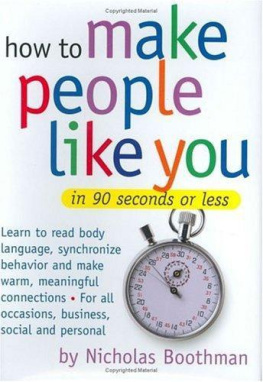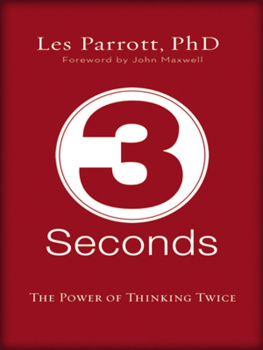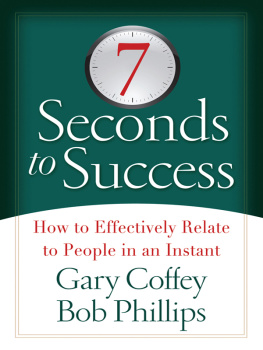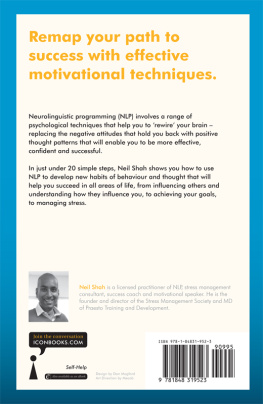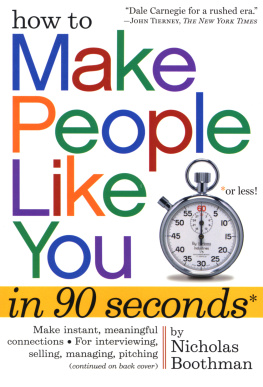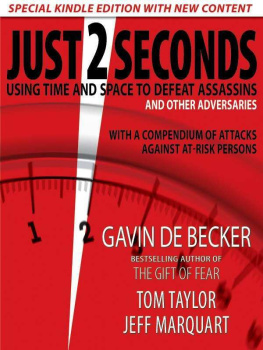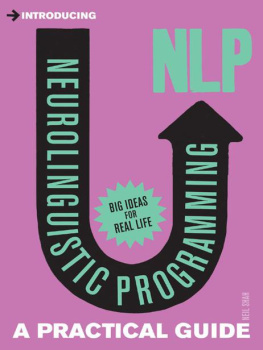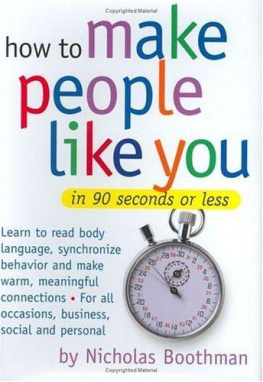Listen - How to Make People Like You in 90 Seconds Or Less
Here you can read online Listen - How to Make People Like You in 90 Seconds Or Less full text of the book (entire story) in english for free. Download pdf and epub, get meaning, cover and reviews about this ebook. City: Roseland;N.J, year: 2013;2000, publisher: Workman Pub.;Listen & Live Audio, genre: Home and family. Description of the work, (preface) as well as reviews are available. Best literature library LitArk.com created for fans of good reading and offers a wide selection of genres:
Romance novel
Science fiction
Adventure
Detective
Science
History
Home and family
Prose
Art
Politics
Computer
Non-fiction
Religion
Business
Children
Humor
Choose a favorite category and find really read worthwhile books. Enjoy immersion in the world of imagination, feel the emotions of the characters or learn something new for yourself, make an fascinating discovery.
- Book:How to Make People Like You in 90 Seconds Or Less
- Author:
- Publisher:Workman Pub.;Listen & Live Audio
- Genre:
- Year:2013;2000
- City:Roseland;N.J
- Rating:5 / 5
- Favourites:Add to favourites
- Your mark:
- 100
- 1
- 2
- 3
- 4
- 5
How to Make People Like You in 90 Seconds Or Less: summary, description and annotation
We offer to read an annotation, description, summary or preface (depends on what the author of the book "How to Make People Like You in 90 Seconds Or Less" wrote himself). If you haven't found the necessary information about the book — write in the comments, we will try to find it.
Listen: author's other books
Who wrote How to Make People Like You in 90 Seconds Or Less? Find out the surname, the name of the author of the book and a list of all author's works by series.
How to Make People Like You in 90 Seconds Or Less — read online for free the complete book (whole text) full work
Below is the text of the book, divided by pages. System saving the place of the last page read, allows you to conveniently read the book "How to Make People Like You in 90 Seconds Or Less" online for free, without having to search again every time where you left off. Put a bookmark, and you can go to the page where you finished reading at any time.
Font size:
Interval:
Bookmark:
How to Make People Like You In 90 Seconds Or Less
The secret of success is not very hard to figure out. The better you are at connecting with other people, the better the quality of your life.
I first discovered the secrets of getting along with people during my career as a fashion and advertising photographer. Whether it was working with a single model for a page in Vogue or 400 people aboard a ship to promote a Norwegian cruise line, it was obvious that for me photography was more about clicking with people than about clicking with a camera. What's more, it didn't matter if the shoot was taking place in the lobby of the Ritz Hotel in San Francisco or a ramshackle hut on the side of a mountain in Africa: the principles for establishing rapport were universal.
For as long as I can remember, I have found it easy to get along with people. Could it be a gift? Is there such a thing as a natural talent for getting along with people, or is it something we learn along the way? And if it can be learned, can it be taught? I decided to find out.
I knew from 25 years of shooting still photographs for magazines all over the world that attitude and body language are paramount to creating a strong visual impressionmagazine ads have less than two seconds to capture the reader's attention. I was also aware that there was a way of using body language and voice tone to make perfect strangers feel comfortable and cooperative. My third realization was that a few well-chosen words could evoke expression, mood and action in almost any subject. With these insights under my belt, I decided to look a little deeper.
Why is it easier to get on with some people than with others? Why can I have an interesting conversation with a person I've just met, while someone else might dismiss that same person as boring or threatening? Clearly, something must be happening on a level beyond our conscious awareness, but what is it?
It was at this point in my quest that I came across the early work of Drs. Richard Bandler and John Grinder at UCLA in a subject with the unwieldy name of NeuroLinguistic Programming, NLP for short. Many of the things I had been doing intuitively as a photographer, these two men and their colleagues had documented and analyzed as the art and science of personal excellence. Among a fountain of new insights, they revealed that everyone has a favorite sense. Find this sense and you have the key to unlock a person's heart and mind.
As my new path became clearer, I set aside my cameras and resolved to focus on how people work on the inside as well as how they look on the outside. Over the next few years, I studied with Dr. Bandler in London and New York and earned a license as a Master Practitioner of NLP. I studied Irresistible Language Patterns in the United States, Canada and England, and delved into everything to do with the brain's part in human connectivity. I worked with actors, comedians and drama teachers in America and storytellers in Africa to adapt improvisational drills into exercises that enhance conversational skills.
Since then I have gone on to give seminars and talks all over the world, working with all kinds of groups and individuals from sales teams to teachers, from leaders of organizations who thought they knew it all to children so shy that people thought they were dim-witted. And one thing became very clear: making people like you in 90 seconds or less is a skill that can be taught to anyone in a natural, easy way.
Over and over I have been told, Nick, this is amazing. Why don't you write it down? Well, I listened, and I have. And here it is.
N.B.
like you, the welcome mat is out and a connection is yours for the making. Other people are your greatest resource. They give birth to you; they feed you, dress you, provide you with money, make you laugh and cry;
they comfort you, heal you, invest your money, service your car and bury you. We can't live without them. We can't even die without them.
Connecting is what our ancestors were doing thousands of years ago when they gathered around the fire to eat woolly mammoth steaks or stitch together the latest animal-hide fashions. It's what we do when we hold quilting bees, golf tournaments, conferences and yard sales; it underlies our cultural rituals from the serious to the frivolous, from weddings and funerals to Barbie Doll conventions and spaghetti-eating contests.
Even the most antisocial of artists and poets who spend long, cranky months painting in a studio or composing in a cubicle off their bedroom are usually hoping that through their creations they will eventually connect with the public. And connection lies at the very heart of those three pillars of our democratic civilization: government, religion and television. Yes, television. Given that you can discuss Friends or The X-Files with folks from Berlin to Brisbane, a case must be made for the tube's ability to help people connect all over the globe.
Thousands of people impact all aspects of our lives, be it the weatherman at the TV studio in a neighboring city, or the technician at a phone company across the continent, or the woman in Tobago who picks the mangoes for your fruit salad. Every day, wittingly or unwittingly, we make a myriad of connections with people around the world.
Attraction is present everywhere in the universe. Whether you want to call it magnetism, polarity, electricity, thought, intelligence or charisma, it's still attraction, and it invests everythinganimal, vegetable or mineral. We form synchronized partnerships natu rally, and although they are hardly noticeable to some, they are quite tangible to others.
We have always relied on emotional contact and signals from our parents, peers, teachers and friends to guide us through our lives. We are influenced by their emotional feedback, their gestures and their way of doing things. When your mother or father sat a certain way, you would do the same; if a cool friend or a movie star walks a certain way, you might adopt a similar gait. We learn by aligning ourselves with the signals other people send us. They impress their way of being on us. We synchronize what we like about them.
People with common interests have natural rapport. The reason you get along so well with your close friends is that you have similar interests, similar opinions and maybe even similar ways of doing things. Sure, you will often find plenty to differ on and argue about, but essentially you are very much like each other.
We human beings are social animals. We live in communities. It's far more normal and even logical for people to get along with one another than it is for them to argue, fight and not get along. The irony is that society has conditioned us to be afraid of each otherto set up boundaries between ourselves and others. We live in a society that pretends to find its unity through love but in actuality finds it through fear. The media scare us half to death with headlines and advertisements continually telling us of earthquakes and airplane crashes and asking us if we have enough insurance, are we too fat, too thin, does the smoke detector work and what about those high funeral expenses? Natural rapport is a prime requirement for our sanity, our evolution and, indeed, our survival.
Perhaps you have traveled abroad to a country where people don't speak your language and you don't understand theirs. You feel a little uncomfortableeven suspiciouswhen you can't be understood. Then suddenly you meet someone from your own country, maybe your own state. This person speaks your language, and whammo, you have a new best friendfor your vacation at least. You might share experiences, opinions, insights, where to find the best restaurants and bargains. You will doubtless exchange personal information about family and work. All this and much more because you share a language. That's rapport by chance. Maybe your enthusiasm will lead you to continue that friendship after returning home, only to discover that apart from language and location the two of you have nothing in common and the relationship fizzles out all by itself.
Font size:
Interval:
Bookmark:
Similar books «How to Make People Like You in 90 Seconds Or Less»
Look at similar books to How to Make People Like You in 90 Seconds Or Less. We have selected literature similar in name and meaning in the hope of providing readers with more options to find new, interesting, not yet read works.
Discussion, reviews of the book How to Make People Like You in 90 Seconds Or Less and just readers' own opinions. Leave your comments, write what you think about the work, its meaning or the main characters. Specify what exactly you liked and what you didn't like, and why you think so.

